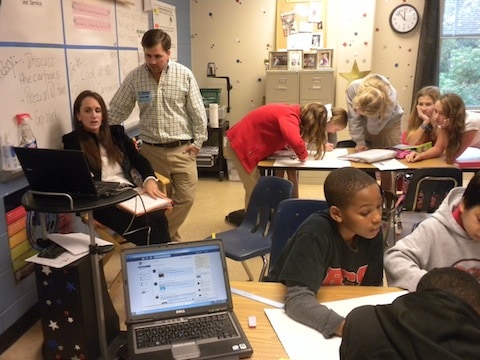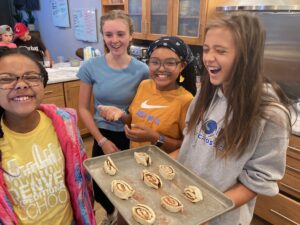Dream Classroom Nets Independent Learners

“Just because kids can make a Glogster, Power Point, or Prezi doesn’t mean they are capable of applying the information they have learned in new and creative ways and have become self-directed learners,” says Susan Fisher, a Program Specialist in the Professional Learning Department for Fulton County Schools in Atlanta, Georgia. She wants students to take over that leadership role as well as responsibility for themselves, not just incorporate “21st Century technologies” into their lessons.
Last year, as the talented and gifted department coordinator and lead technology teacher at Fulton’s Ridgeview Charter School, she began presenting regionally on blogging, e-portfolios, and other cutting edge topics. “Lightning struck me during one such event and before I could change my mind, I texted my principal with the ominous message, ‘I want to revamp everything and create a flipped, gamified, differentiated, inspired, and project based classroom for next year.’ Fisher spent the summer gamifying her entire seventh grade social studies curriculum, with the full support of her principal.
Fisher had all the desks removed from her classroom and replaced them with tables, each with an Internet connected computer, to encourage collaboration between groups of 3-5 students. The videos, projects, and gaming excite the kids and motivate them to push through the curriculum like they had never done before. “By the nine week mark I had already saved 23 academic teaching days and the scores on the same standardized tests from the year before were all equivalent or better on average!” Projects such as creating political cartoons after research at home take life in the group setting. The flexibility of the Inspired Classroom, in conjunction with the Flipped model, has allowed her to move away from the traditional linear, sequential, and lecture-based teacher model, instead filling the role of a facilitator who sets up a series of activities that lead the students as they learn on their own.
She also created a differentiation site called ‘Choose Your Own Adventure’ based on an existing model, and modified it to meet the needs of her course. The website allows students to pick from dozens of different project choices to earn points and demonstrate mastery of various teaching standards, addressing different levels and learning styles. The site lets students be totally creative with their projects, as long as they satisfy the rubric. Projects include describing the apps on Osama bin Ladin’s phone and his daily schedule, or writing an Ottoman report card, or song lyrics, or building a new weapon.
The time flexibility and teaching days gained enabled her students to participate in the Urgent Evoke Game created by Jane McGonigal and the World Bank Institute. “It has helped my students learn and really appreciate their role as global citizens. I even incorporated in my Collabornation site the Evoke game’s central themes: food security, energy, water security, disaster relief, poverty, pandemic, education, global conflict, and human rights. Who knew I could get such great results and emphasize higher order thinking and problem solving skills at the same time? I have truly created my Dream Classroom Model.”
Fisher says her biggest take away thus far is that others want to pigeonhole the success of her dream class model to just one of its components instead of looking at it in its entirety. “In reality, each piece enhances and plays off the other to change the paradigm — changing students’ expectations not to be spoon fed, and expecting interaction with classmates to be part of learning. Two important questions remain my guiding light to ensure that I am making student centered decisions instead of falling for easy answers and quick fixes: 1) What is the best use of my students’ face time with me and, 2) even more importantly now, with each other.”
Jennifer Klein, a principal in the PR firm JMK & Associates in Atlanta, Georgia, is a writer and media publicist focusing on education, sports, and the arts. She frequently writes about newsworthy educational programs for Fulton County Schools, where she has held leadership roles as a parent and community member for the past 20 years. Contact: [email protected]






Catherine Owen
What a great teacher! What lucky kids to get to be in her class!